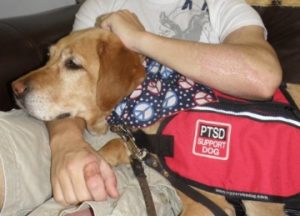Family pets may be used if they meet age, size and temperament requirements. Recently, a much needed boost to this modality was given when the Justice Department redefined regulations clarifying parts of 1990’s Americans with Disabilities Act.
To qualify as a service dog, the dog must be trained according to Americans’ Disabilities Act guidelines to do work or perform tasks for persons with MIADS. Dogs do not have to be formally trained by an ADI approved school.
Time Magazine quotes, “Walter Reed Medical Center and other military medical centers have started stationing dogs on hospital floors to help calm patients.” There are multiple organizations training dog to perform multiple tasks for wounded warriors. According to Jim Stanek, Paws and Stripes in Albuquerque, NM, “Your average service dog coming out of these agencies can do 82 different tasks. But if you’ve got a veteran whose main problem is MIADS, what does turning on a light switch do for him?”
 This is where we step in. According to Minnesota Senator Al Franken, “I really believe the dogs can provide tremendous benefits. The whole point of this is to measure in a scientifically valid way what the benefits are of service dogs to vets with psychological injuries and make a better life for these guys and women who have put everything on the line for us.”
This is where we step in. According to Minnesota Senator Al Franken, “I really believe the dogs can provide tremendous benefits. The whole point of this is to measure in a scientifically valid way what the benefits are of service dogs to vets with psychological injuries and make a better life for these guys and women who have put everything on the line for us.”
As many as 400,000 troops are possibly returning with the symptoms of MIADS. Dog partners have a tremendous stress reduction effect on their human partners as measured through cortisol levels, heart rate and blood pressure. These dogs can quite literally become a serviceman’s or servicewoman’s best friend.


